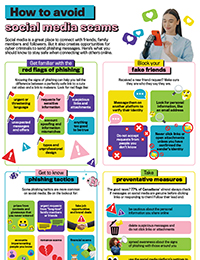
Social media is a great place to connect with friends, family members and followers. But it also creates opportunities for cyber criminals to send phishing messages. Here’s what you should know to stay safe when connecting with others online.
Get familiar with the red flags of phishing
Knowing the signs of phishing can help you tell the difference between a perfectly safe link to a cute cat video and a link to malware. Look for red flags like:
- urgent or threatening language
- requests for sensitive information
- suspicious links and attachments
- unexpected messages and offers
- account spoofing and information mismatches
- anything too good to be true
- typos and unprofessional design
Block your fake friends
Received a new friend request? Make sure they are who they say they are.
- Message them on another platform to verify their identity
- Look for personal information, like an email address
- Do not accept requests from people you don’t know
- Never click links or open attachments unless you have confirmed the sender’s identity
Get to know phishing tactics
Some phishing tactics are more common on social media. Be on the lookout for:
- prizes from contests and giveaways that you never entered
- urgent requests from “long-lost” family members or friends
- fake job opportunities and brand deals
- accounts impersonating people you know
- romance scams
- financial scams
Take preventative measures
The good news? 77% of CanadiansFootnote 1 almost always check whether messages on social media are genuine before clicking links or responding to them! Follow their lead:
- be cautious about the personal information you share online
- delete suspicious messages and do not click links or attachments
- spread awareness about the signs of phishing with those around you
Get more tips to protect yourself and your accounts at
GetCyberSafe.ca
